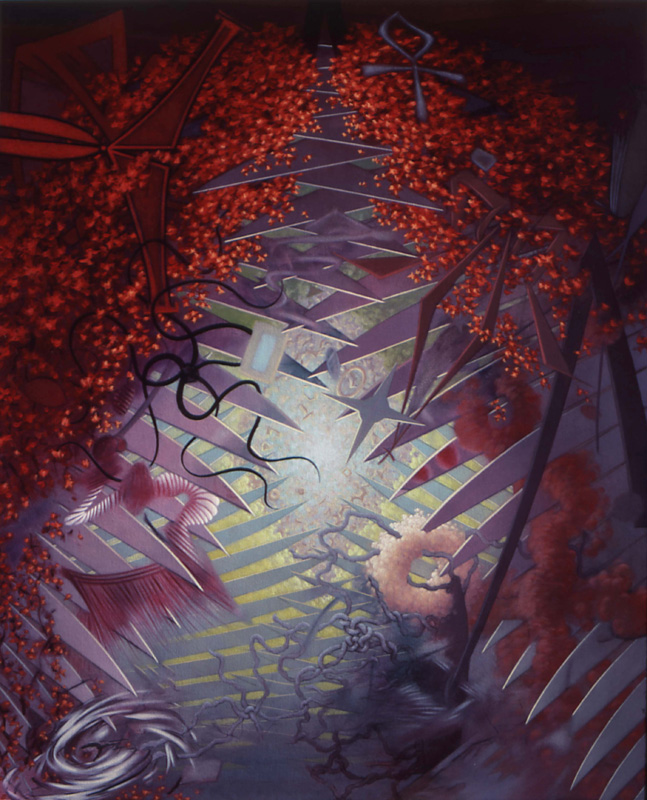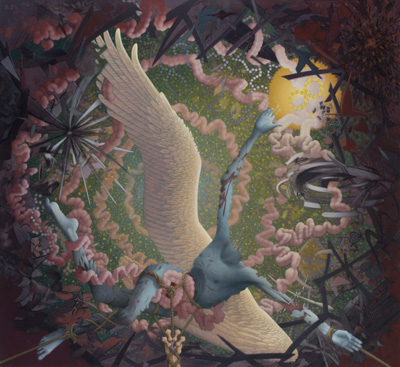
 |
| Knife Vortex 1987, acrylic on canvas, 66 x 48 in. |
Knife Vortex |
Knife Vortex was painted in early 1987 at the tail end of a 14-plus year period of abstraction. It was also done the same year I first introduced the human figure to my work. In the painting, like in all my abstractions, I pursued the ideas of change and transformation. To express the ideas I used a language of forms developed over the course of those years. The forms can be generally characterized as amorphous, lacking specific identities, and existing on the edge of recognizability. To further enhance the ideas I placed the forms in dynamic spaces with the intent of creating a world full of movement – a world in flux. In the early abstractions the forms were similar in shape, but as time passed they became more distinct. The spaces on the other hand became more and more contiguous after initially being fractured and chaotic. This resulted in more organized compositions. These characteristics reached a pinnacle in Knife Vortex when the more distinct forms and the contiguous spaces were unified in a center-focused composition. In Knife Vortex most of the forms exist in the foreground space. They generally have a strange, mysterious, and threatening presence. Prominent among them are two series of knife-like forms. One series slash up from the lower corners of the canvas, scissor together around half way up, and then end at the middle top. The other series is positioned deeper in space, beyond the first, and slash down, scissor together around half way down, and then disappear at the middle bottom. Together they create a window or vortex that frames, and seemingly guards, the entrance to a deep transcendent space at the center of the composition. This framing acts to lure the viewer's eye into the deep space, figuratively pulling them into the painting. The result is the viewer must to pass though the gauntlet of knives and other threatening forms to reach the transcendent space. Having arrived at the calm center the viewer is then rewarded with a sense of liberation from the threat. |
 1987, acrylic on canvas, 66 x 48 in. |
 1990, acrylic on canvas, 66 x 72 in. |
As a side note, a few years later in 1990 I revisited the vortex composition in the painting Winged Figure in a Vortex. In it I include a human figure to represent the viewer being drawn down into a vortex. Many of the forms in Knife Vortex have specific references and/or symbolic meanings. The overall composition, with its relationship of threatening forms in the foreground to the deep transcendent space beyond, references the harsh realities of earthly existence juxtaposed to a purer form of existence in the deep space. The blood-red confetti-like forms that populate the upper half of the canvas and cascade down after being shredded by the knives evoke a sense of violence and destruction. The handle-shaped cross or ancient Egyptian hieroglyph "ankh" is positioned in the top middle right. It references the key or breath of life and reinforces the idea that the foreground represents earthly corporeal existence. Lastly, the spiraling form in the lower left corner, as well as the shredded forms above it, represents change and transformation. These are just a few of the references and symbols available for the viewer to explore. Ultimately Knife Vortex is a representation of both our earthly existence and the hope of a transcendent afterlife. This is a core aspect of the human condition. We all suffer and endure the pains and challenges of life while concurrently yearn for a sense of peace and tranquility beyond that world. It is a message that evokes spiritual and philosophical implications. - Brian Mains, August 2021 |